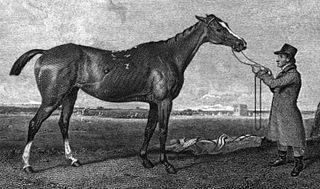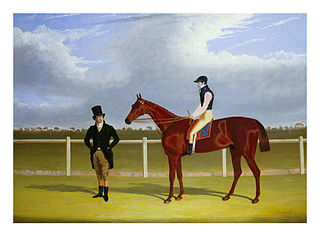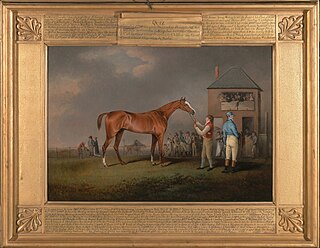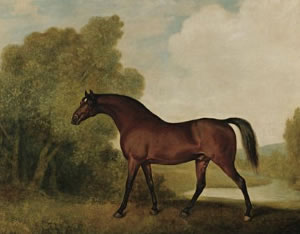
Citation was a champion American Thoroughbred racehorse who is the eighth winner of the American Triple Crown. He won 16 consecutive stakes races and was the first horse in history to win US$1 million.

Fair Grounds Race Course, often known as New Orleans Fair Grounds, is a thoroughbred racetrack and racino in New Orleans, Louisiana. It is operated by Churchill Downs Louisiana Horseracing Company, LLC.
Ian Balding is a retired British horse trainer. He is the son of the polo player and racehorse trainer Gerald Matthews Balding and the younger brother of trainer Toby Balding. Ian Balding was born in the US, but his family returned to the UK in 1945. He was educated at Marlborough College and Millfield school in Somerset. He went up to Christ's College, Cambridge, in 1959 to read Rural Estate Management, where he played Rugby for the university team, gaining his Blue in 1961 at full back. He started training in 1964. Kingsclere became his home at the age of 26 and it is here that earned his reputation as an internationally respected trainer.
Black Helen was an American Thoroughbred race horse who was named the Champion three-year-old filly of 1935 after winning eight races that year including the Coaching Club American Oaks, Florida Derby, Maryland Handicap and American Derby, becoming only the second filly to win the latter. Black Helen was inducted into the National Museum of Racing and Hall of Fame in 1991, one year after her full-brother Bimelech.

For the Greek statesman of this name, see Timoleon.
The Narragansett Special was an American Thoroughbred horse race run annually at Narragansett Park in Pawtucket, Rhode Island. At the time of its inaugural running in 1934, the Narragansett Special offered a purse of $32,500 added money making it the biggest race run at the track. Only Suffolk Downs' Massachusetts Handicap, which ran the next summer, had a bigger purse in New England. Both rich contests drew the best talent that the nation had to offer.
Further Flight was an Irish-bred, British-trained thoroughbred racehorse best known for winning the Jockey Club Cup for five successive years. In a career which lasted from October 1988 until October 1998, he ran seventy times and won twenty-four races. In 1995, Further Flight was voted European Champion Older Horse at the Cartier Racing Awards. He is the only horse to win the same European Group race five times.

Tiresias (1816–1837) was a British Thoroughbred racehorse and sire. In a career that lasted from April 1819 to July 1820 he ran thirteen times, all but two of them at Newmarket and won eleven races. Both of his defeats came when he was attempting to concede weight to opponents in match races. His most important win came in May 1819 when he won the Derby. Tiresias's racing career was ended by injury in the summer of 1820, after which he was retired to stud.

Rhoda was a British Thoroughbred racehorse and broodmare who won the third running of the classic 1000 Guineas at Newmarket Racecourse in 1816 and was the most successful racehorse in Britain two years later. Rhoda was one of the most active of all British classic winners, running in at least forty-five contests between 1816 and 1820 and winning twenty-one times. Her actual number of competitive races was even higher as many of her later races were run in multiple heats, with the prize going to the first horse to win twice. She won the 1000 Guineas on her second appearance but did not run as a three-year-old after finishing unplaced in the Oaks Stakes. Rhoda won three races in 1817, ten in 1818, four in 1819 and two in 1820.

Rowton (1826–1841) was a British-bred Thoroughbred racehorse and sire best known for winning the St Leger Stakes in 1829. He was lightly campaigned during his racing career, competing in eleven races in five seasons and winning seven times. Until his last competitive season he was raced exclusively in Yorkshire running only at the meetings at York in August and Doncaster in September. Apart from the St Leger, his wins included the York Two-year-old Stake, the Great Subscription Purse and a division of the Oatlands Stakes. On his final appearance he ran a dead heat for the Ascot Gold Cup before being beaten in a run-off by the filly Camarine. After three seasons at stud in England he was exported to the United States where he died in 1841.

Theodore was a British Thoroughbred racehorse and sire best known for winning the classic St Leger Stakes in 1822 at odds of 200/1. Trained in Yorkshire by James Croft, he won the second of his two races as a two-year-old and showed good form the following year, winning races at Catterick, York and Newcastle. His St Leger prospects, however, appeared remote after health problems and poor performances in training gallops. His upset win in the classic, followed by a poor run over the same course and distance two days later, attracted a great deal of comment and suspicions of race-fixing, although none of the allegations was ever proved.
Petronius (1805–1823) was a British Thoroughbred racehorse and sire best known for winning the classic St Leger Stakes in 1808. After winning the St Leger as a 20/1 outsider, Petronius remained in training for two more years, winning two races at York in 1809 and the Union Cup at Preston in 1810. He retired from racing after winning five races from eleven starts. He had little success as a breeding stallion and died in 1823 at the age of eighteen.

Quiz (1798–1826) was a British Thoroughbred racehorse and sire best known for winning the classic St Leger Stakes in 1801. Quiz was a durable, top-class performer, winning at least once a year in racing career which lasted seven seasons from August 1801 until April 1807. Apart from the St Leger he won many other important races including three Brocket Hall Gold Cups, two Oatlands Stakes at Newmarket Racecourse, a Great Subscription Purse at York, a King's Plate and the Jockey Club Plate. In all he won twenty-one times in thirty-six races for four different owners before being retired to stud, one of which was Mr Hallett Esq, where he proved to be a successful sire of winners.
Cockfighter (1796–1807) was a British Thoroughbred racehorse and sire best known for winning the classic St Leger Stakes in 1799. In a racing career which lasted from May 1799 until August 1802 he won ten of his eighteen races. Originally named Abraham Newland, he was renamed to reflect the sporting interests of Henry Tempest Vane who bought the horse in the summer of his three-year-old season. After bolting on his racecourse debut, Cockfighter was undefeated for more than two years, winning the St Leger, the Doncaster Cup, and three divisions of the Great Subscription Purse at York, and was regarded as the best horse in Northern England. He won the Craven Stakes in 1802, but was retired from racing after a run of defeats later that year. He had little opportunity to establish himself as a breeding stallion, dying in 1807 after four seasons at stud.

Ambrosio was a British Thoroughbred racehorse and sire best known for winning the classic St Leger Stakes in 1796. In a racing career which lasted from May 1796 until September 1799 he won fifteen of his twenty-three races. As a three-year-old he was based in Yorkshire, where he won his first three races before justifying his position as odds-on favourite for the St Leger, beating six opponents. In the next two years he competed mainly at Newmarket, where his victories three divisions of the Oatlands Stakes and the Jockey Club Plate. He returned to Yorkshire as a six-year-old to win a division of the Great Subscription Purse at York before being retired to stud. Ambrosio stood as a breeding stallion in Great Britain and Ireland, but had little success as a sire of winners.

Henry Augustine Tayloe was an American planter, slaveholder, horse breeder and racer, and land speculator in Alabama during the 19th century.
Grenada was an American Thoroughbred racehorse. He won the 1880 Preakness Stakes, Belmont Stakes, and Travers Stakes. He is one of only seven horses to have won these three races.
The Washington Jockey Club was an American association in Washington, D.C. devoted to horse racing, founded in 1797. The club established its first racecourse four blocks from the Executive Mansion where it extended from 17th and 20th Streets and extending across Pennsylvania Avenue into Lafayette Park, what is now the site of Decatur House at H Street and Jackson Place, crossing Seventeenth Street and Pennsylvania Avenue to Twentieth Street, largely on the site of today’s Eisenhower Executive Office Building. The course was relocated in 1802 to the Holmead Farm two miles north of the Executive Mansion, to what is now Meridian Hill.
Leviathan (1823-1846) was a British Thoroughbred racehorse who won 16 of 21 starts before injury prompted his retirement. Imported into Tennessee in 1830, he was the leading sire in North America of 1837, 1838, 1839, 1843 and 1848, and also finished second five times. He was also an important broodmare sire, with modern descendants through the female line including Affirmed, Alydar and Dance Smartly.
Condado was a champion racehorse in Puerto Rico who was best known for his statistical achievements on the track which included having 152 career victories and at his peak a winning streak of 43 straight victories.









